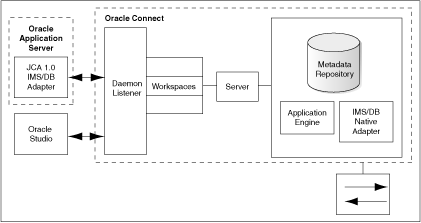|
Oracle® Application Server Adapter for IMS/DB User's Guide
10g Release 2 (10.1.2) B15806-01 |
|
 Previous |
 Next |
|
Oracle® Application Server Adapter for IMS/DB User's Guide
10g Release 2 (10.1.2) B15806-01 |
|
 Previous |
 Next |
The Oracle Application Server Adapter for IMS/DB (OracleAS Adapter for IMS/DB) provides connectivity and runs interactions on an Information Management System - Data Base (IMS/DB) system. This chapter provides an overview of the features and architecture of OracleAS Adapter for IMS/DB.
This chapter contains the following sections:
IMS/DB (Information Management System - Data Base) is a high-performance hierarchical database. The data access API to IMS/DB is called DL/I, which is a function by which the IMS/DB database can be traversed and operated on. Working with DL/I requires the caller to run under the control of IMS/DB. APIs are also available to enable access to IMS/DB from CICS and IMS/TM transactions.
OracleAS Adapter for IMS/DB includes the following feature:
Captures and maintains a metadata schema for IMS/DB by importing various IMS definition files such as a PSB file, DBD files, and COBOL copybooks. These are transformed into mapping definition for Oracle Connect for IMS/DB on the OS/390 computer.
Uses an enterprise application integration (EAI) model. Users of a requesting application can model the interactions that they want implemented, specifying what each interaction does, when it occurs, and the inputs and outputs expected for each interaction. Moreover, the OracleAS Adapter for IMS/DB maps data structures, facilitating access to IMS/DB data from within Oracle Application Server.
Implements interactions as parameterized SQL with the parameters forming the input record, and with the output (in cases where there is an output) aggregated into an XML document forming the output record.
Includes the options to access IMS/DB data managed by CICS, IMS/TM, or directly.
Does not support two-phase commit and cannot participate in a distributed transaction.
OracleAS Adapter for IMS/DB includes the following components:
J2CA 1.0 VSAM adapter: The J2CA IMS/DB adapter is a standard resource adapter that is compliant with J2EE Connector Architecture, therefore, providing J2EE components connectivity.
Oracle Connect: Oracle Connect runs on the legacy system and handles requests from the J2CA 1.0 IMS/DB adapter, that runs within Oracle Application Server Containers for J2EE (OC4J).
Oracle Studio: Oracle Studio is the configuration tool for Oracle Connect. Configuration tasks using Oracle Studio are performed on a Windows platform. Oracle Studio uses perspectives that enables you to generate specific information necessary to model OracleAS Adapter for IMS/DB.
The following figure illustrates the components of OracleAS Adapter for IMS/DB.

The J2CA 1.0 IMS/DB adapter converts the J2CA interaction invocation received from Oracle Application Server to the XML format and passes the XML format to Oracle Connect on the legacy server. The daemon listens for the request coming from the J2CA 1.0 IMS/DB adapter client and assigns a server process to handle the request. The properties of the server process, such as connection pooling requirements, are defined by a workspace definition within the daemon. The server process includes an instance of the application engine, which converts the XML format into standard SQL which is passed to the data engine. The data engine processes the SQL to create an efficient strategy for retrieving the data from IMS/DB and then passes the SQL and execution strategy to the database back-end adapter. The database back-end adapter passes the SQL to the back-end driver, which converts the SQL to the language understood by IMS/DB and passes it to IMS/DB to be executed. The results of the SQL statement are passed back to the application engine, through the back-end adapter, where these results are converted to XML and passed back to the client.